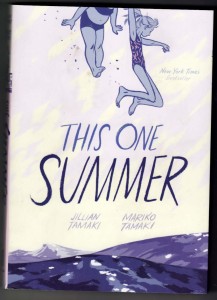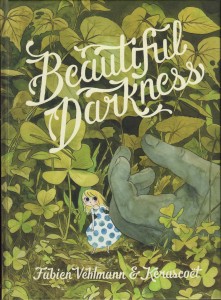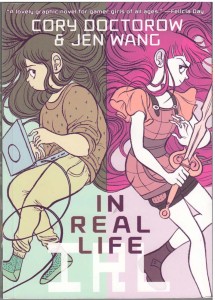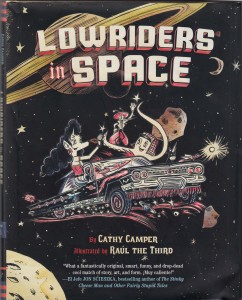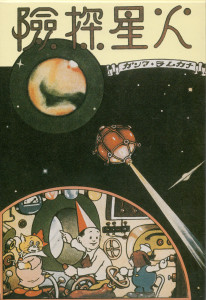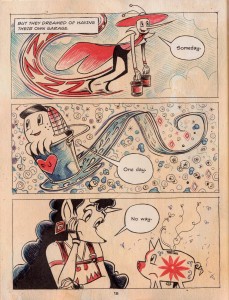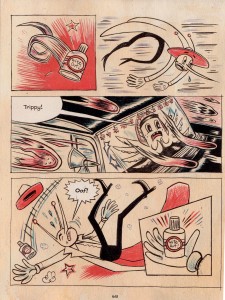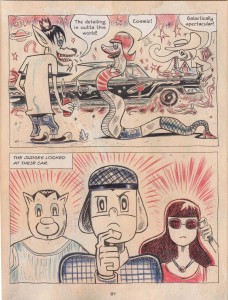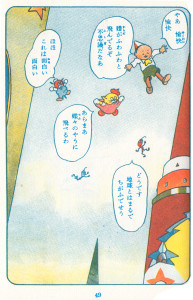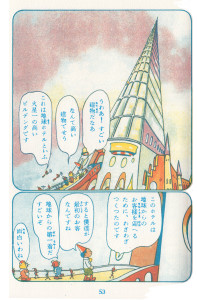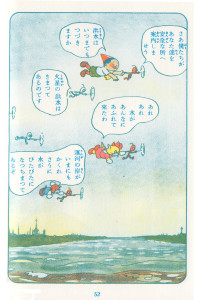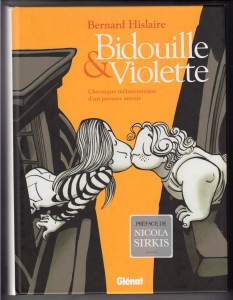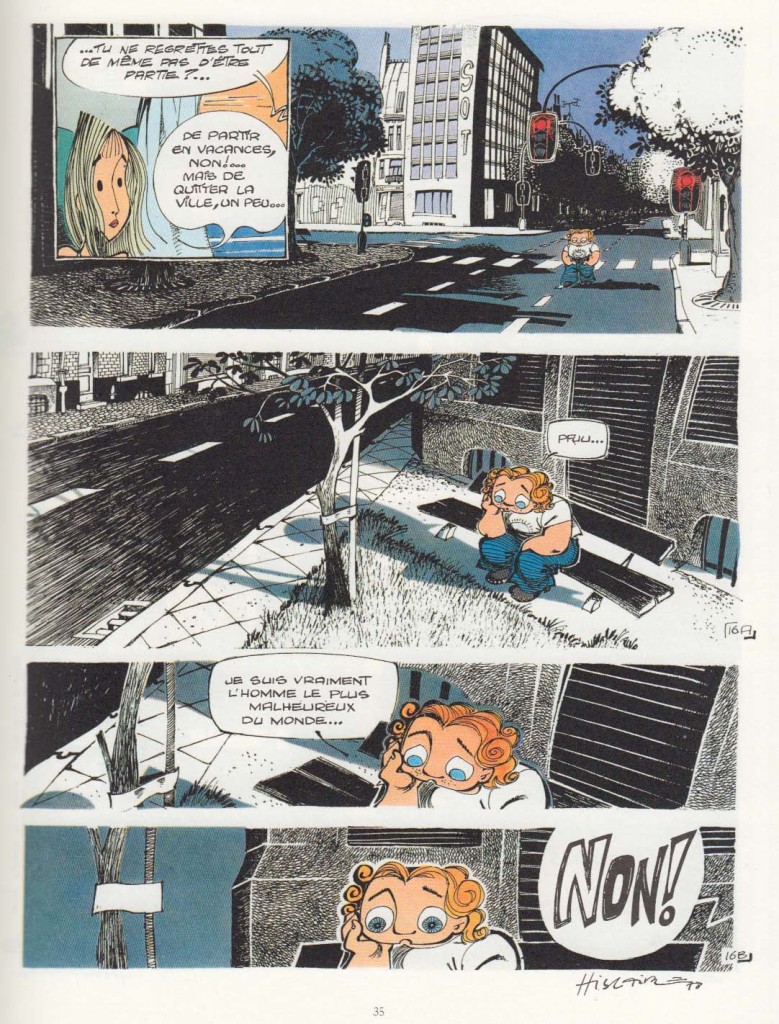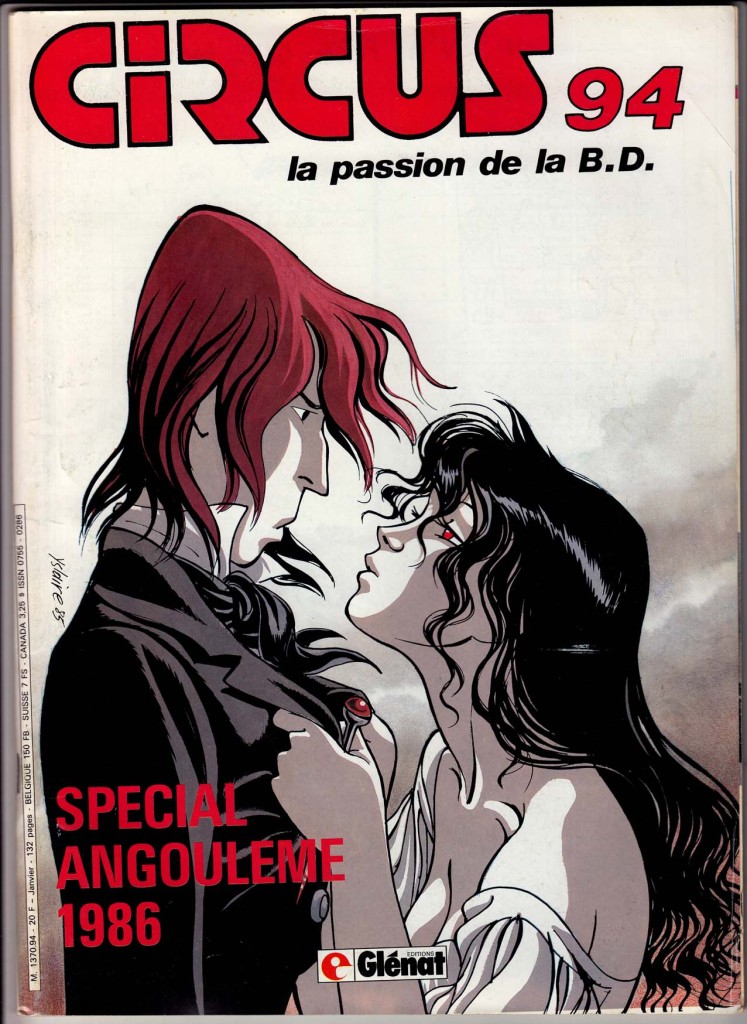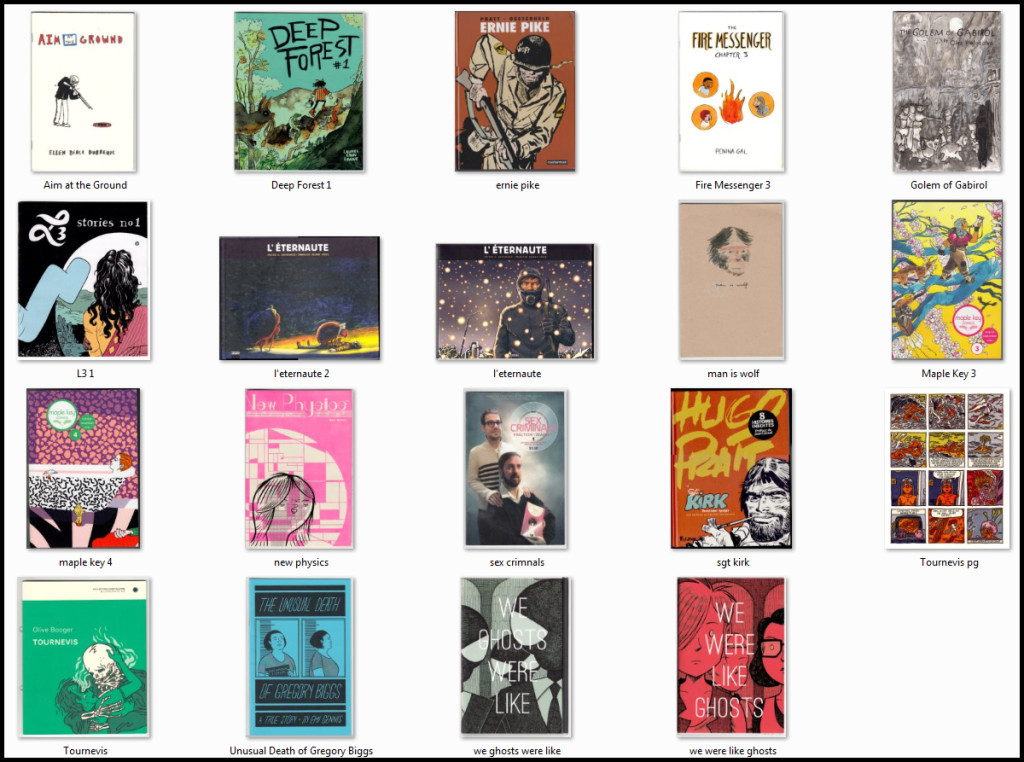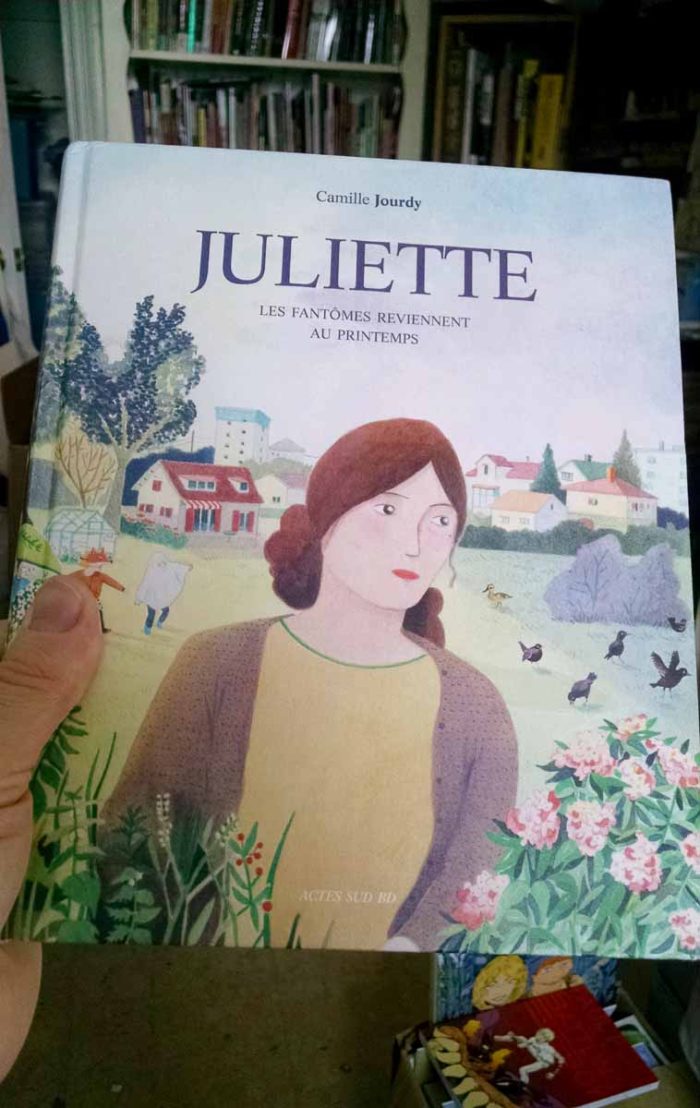 Juliette: les fantômes reviennent au printemps (Juliette: the ghosts return in spring) is a 240-page French graphic novel, published by Actes Sud in 2016. I don’t know much about Camille Jourdy : she’s done a lot of children’s books, and had a previous series of bd albums, Rosalie Blum, which I guess was successful, since it was adapted as a film as well.
Juliette: les fantômes reviennent au printemps (Juliette: the ghosts return in spring) is a 240-page French graphic novel, published by Actes Sud in 2016. I don’t know much about Camille Jourdy : she’s done a lot of children’s books, and had a previous series of bd albums, Rosalie Blum, which I guess was successful, since it was adapted as a film as well.
Category: Recommended Reading
The Reading Pile – June 2015
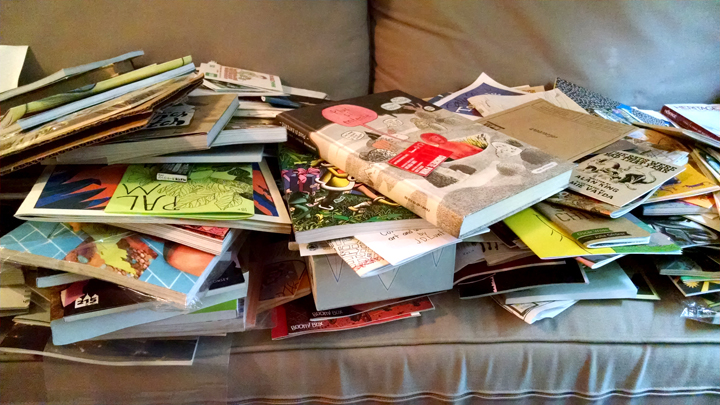 The to-read pile looms – graphic novels, anthologies, mini-comics, floppies, journals  — there’s a couch under it somewhere, if I remember correctly.  I must climb this mountain one comic at a time…
The to-read pile looms – graphic novels, anthologies, mini-comics, floppies, journals  — there’s a couch under it somewhere, if I remember correctly.  I must climb this mountain one comic at a time…
Last month, I read comics by Marnie Galloway, Adrian Tomine, Heide Solbrig, Ben Doane/Olivia Li/ Jamie Koh, Catalina Rufin, M.R. Trower, Kelly Froh and Max Clotfelter, Max de Radigues, Keiler Roberts, and the Kimball Anderson-edited anthology “Inaction Comics.”
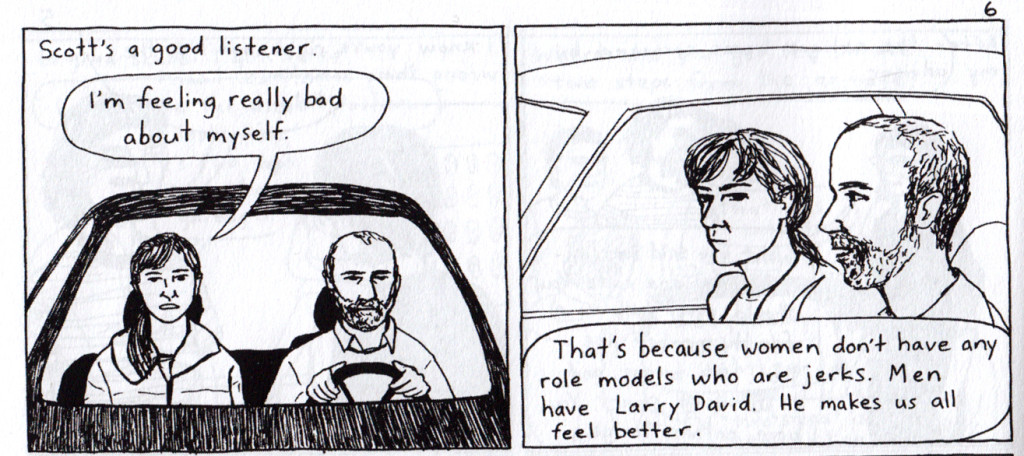
Too often people ask me, “what have you been reading lately?” and I don’t even remember. So here’s a way to keep track of/share at least some what I’m reading, especially the good stuff. I’m going to see if I can do it on a monthly basis:
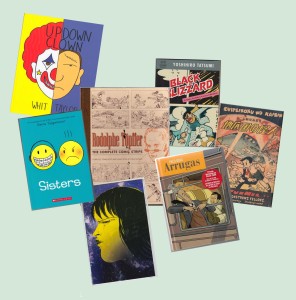
Not the sort of reading month I had planned — little progress in my huge pile of minis and graphic novels I’ve acquired over the last… oh, year, year and a half. Alexander Danner and I were asked to contribute a chapter on “The International Graphic Novel,” for a collection, so I re-read some stuff for that — which is great. Hard to find time to re-read things, but it’s always worthwhile. But I did squeeze in some “first reads” as well…. (read more)
DECEMBERÂ 2014
I Â didn’t read a whole lot of comics this month, compared to previous months. Especially not a lot of minicomics. I think the only minis I cleared from my huge “to-read” pile were:
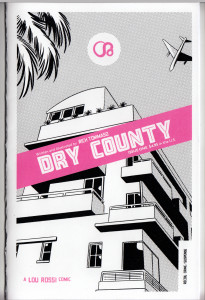 |
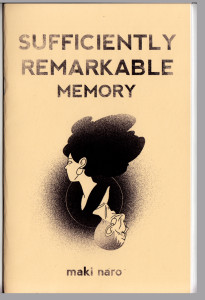 |
| Dry County by Rich Tommaso. I’ve always liked Tommaso, who works in the alt-comics tradition of Dan Clowes, Charles Burns, David Mazzuchelli et al.; his work has a similiar style and themes to those guys but has never hit it big with a graphic novel (yet). This one is a Florida-set noir-ish mini about a down-at-the-mouth cartoonist (what a surprise) and a femme fatale with some fucked-up baggage (it’s chapter one, I think the series runs on Act-i-vate, but I’d rather find the next mini). (update: I ordered it from him online at http://recoilcomics.bigcartel.com/) | Sufficiently Remarkable: Memory by Maki Naro. A mini I got at MICE 2014. Another one that comes out of a webcomic, it’s a touching little comics poem about the protagonist’s grandfather’s failing memory. |
I spent some time this month catching up on a few of the GNs that got a lot of attention this year, including a couple that made a lot of the “Best of the year” lists:
Then, two great kids’ adventures in space comics, made on two different continents, 75 years apart, but seem to me to have a certain kinship:
It doesn’t come up in any of the histories of Franco-Belgian comics that I’ve read, but I saw this page online while browsing original art sites. 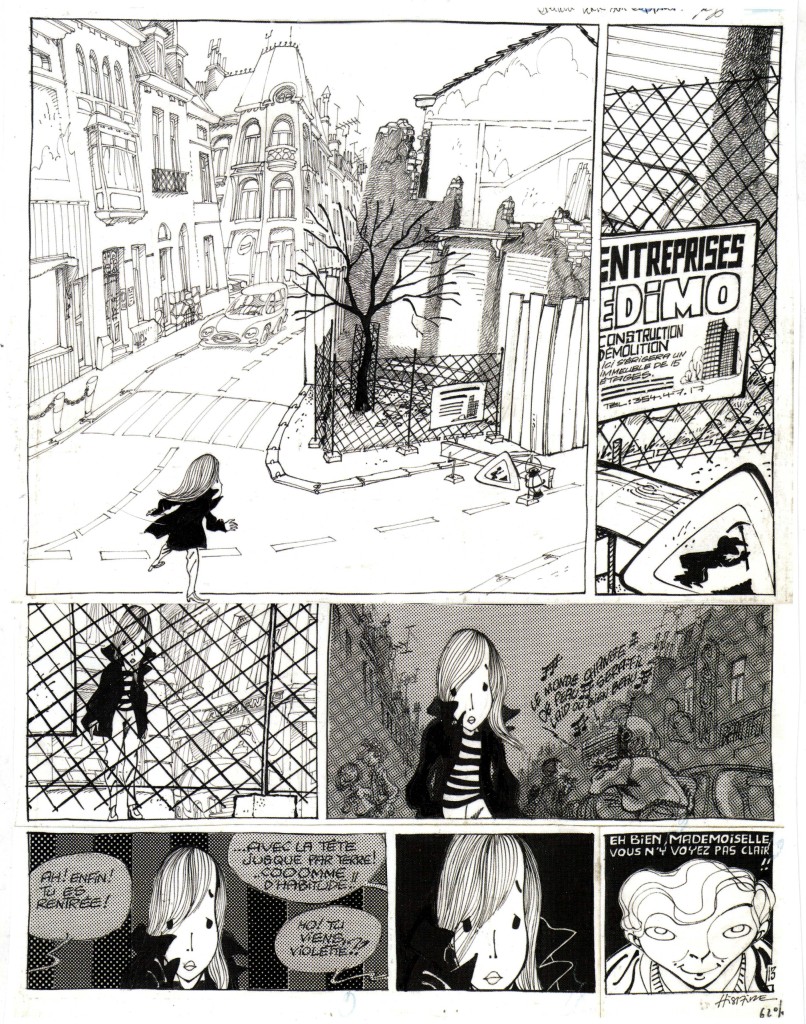 I was intrigued by the unusual line-work and atmosphere, the drama created by the page, the way he draws the hair and the weird eyes. Â The page stuck in my mind, and after some months of vacillating, I sprang for the collection from Amazon France.
I was intrigued by the unusual line-work and atmosphere, the drama created by the page, the way he draws the hair and the weird eyes. Â The page stuck in my mind, and after some months of vacillating, I sprang for the collection from Amazon France.
The love is between two shy teenagers in a provincial French-or-Belgian city (the fictional town of Mayon, so that the inhabitants can be referred to as Mayonnaise, *chuckle*), their innocent youthful passions somewhat inexplicably foiled by un-supportive parents. At first, I found the comic a little too twee, but by the end of the book, which comprises material that made up four albums, I felt positively about it; it’s rather uneven, perhaps reflecting the youth of its artist-writer Hislaire (just 21 years old when the series began). The early chapters do verge on twee-ness, as we meet the tender young proagonists and follow their halting progress toward young love. There’s a lot of graphic energy and inventiveness, though: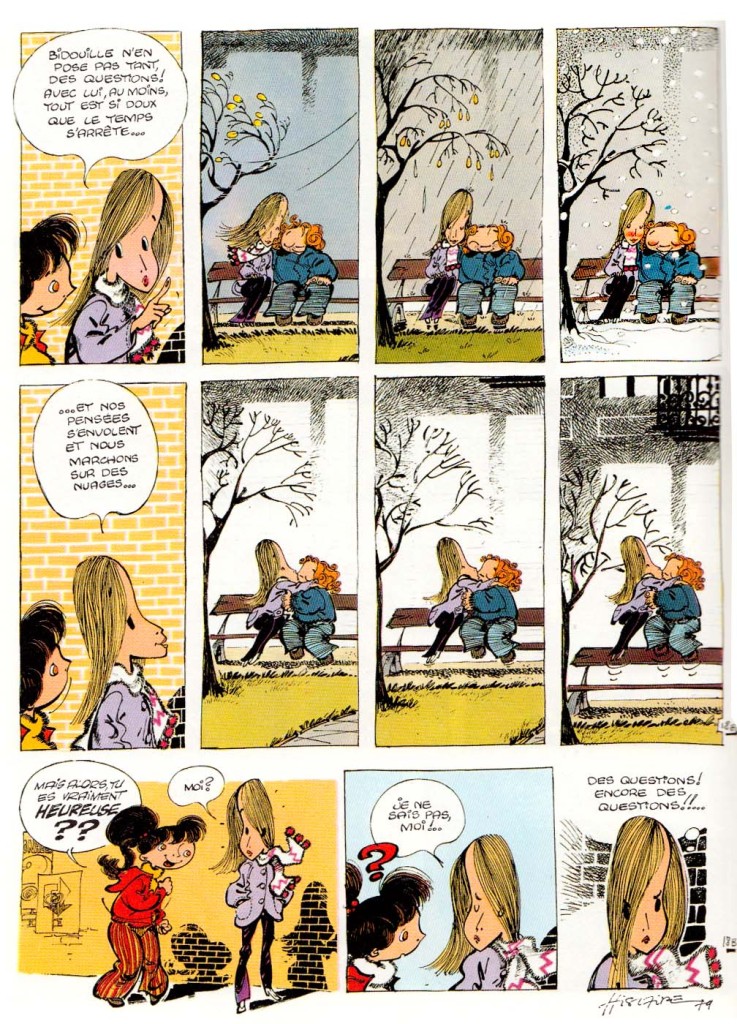
Then there are some episodes of misunderstandings and jealousy, from which we veer into a psychedelic dream sequence that takes up nearly a full album…
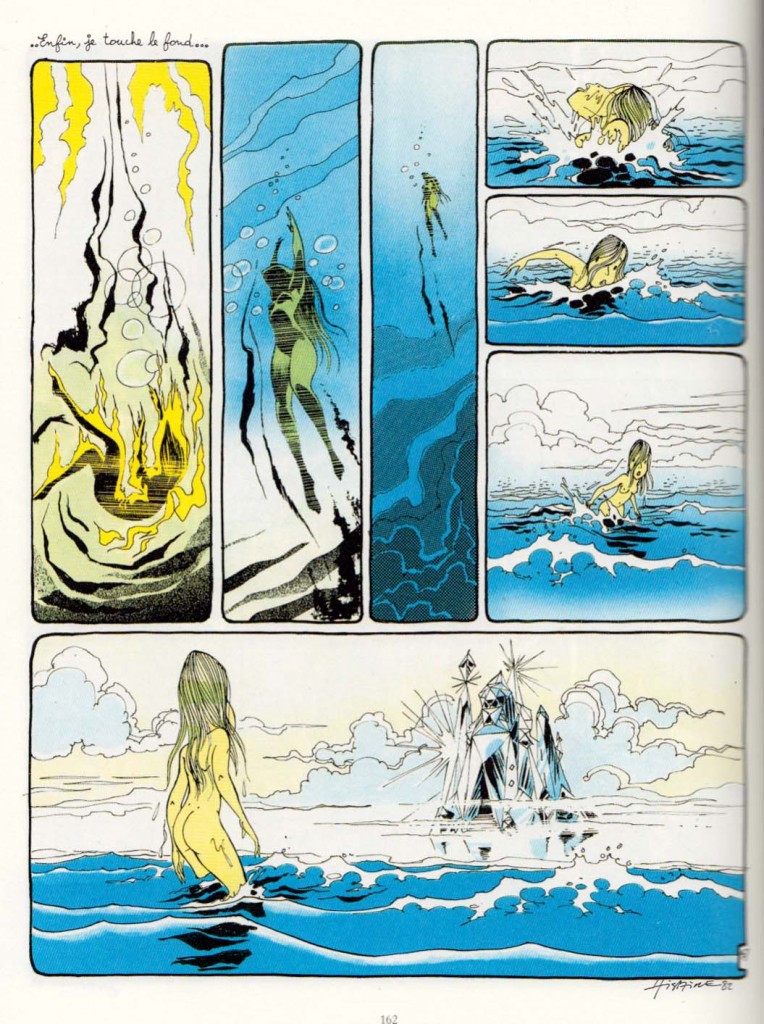 …followed by a slightly absurbist episode of B & V going on an urban “mountain climbing” adventure over the roofs of the town. Â
…followed by a slightly absurbist episode of B & V going on an urban “mountain climbing” adventure over the roofs of the town.  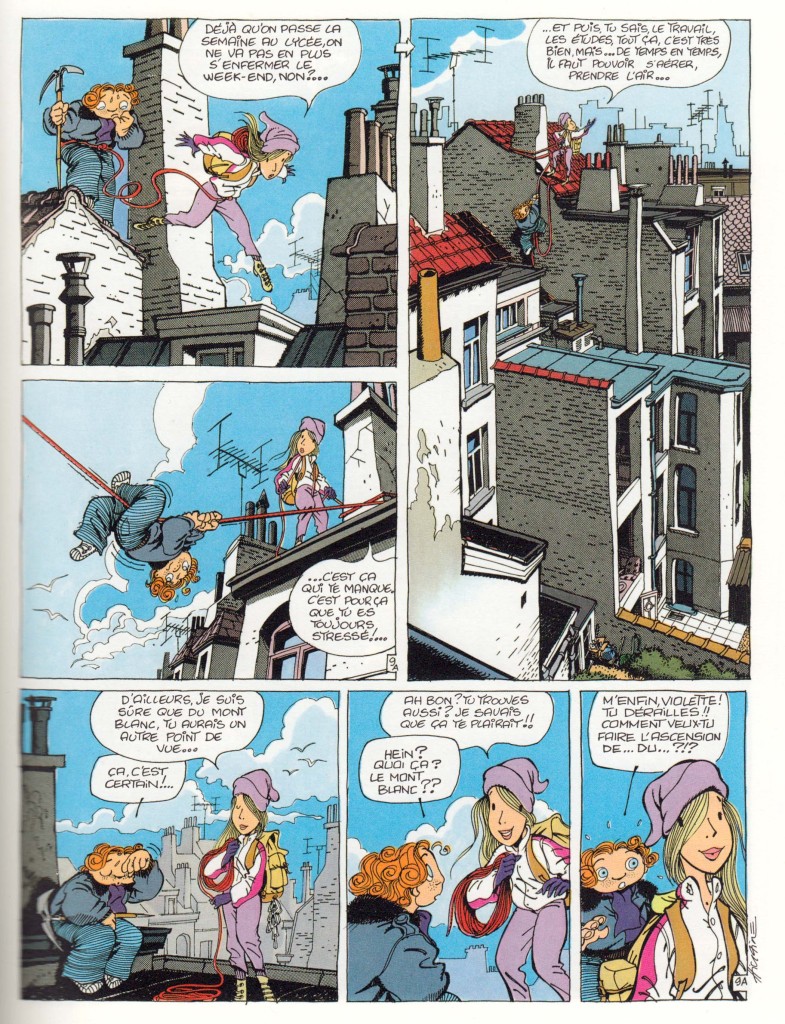 Finally the story resolved by invoking Romeo and Juliet for a surprisingly dark conclusion.
Finally the story resolved by invoking Romeo and Juliet for a surprisingly dark conclusion.
Despite this somewhat flailing approach to story, there’s a sincerity and intensity of feeling that I bet accounts for the fond memories it inspires in those who read it as adolescents. Throughout it all, I remained fascinated by Hislaire’s style, which falls into neither of the two dominant Franco-Belgian “schools”: the precise, Hergean ligne claire style, or the rounded Andre Franquin-ish look that generally charactertized Spirou. Hislaire favors eccentric shapes for his characters’ heads and figures, a wide variety of types of line and texture marks, all contributing to the loose, askew world he creates. 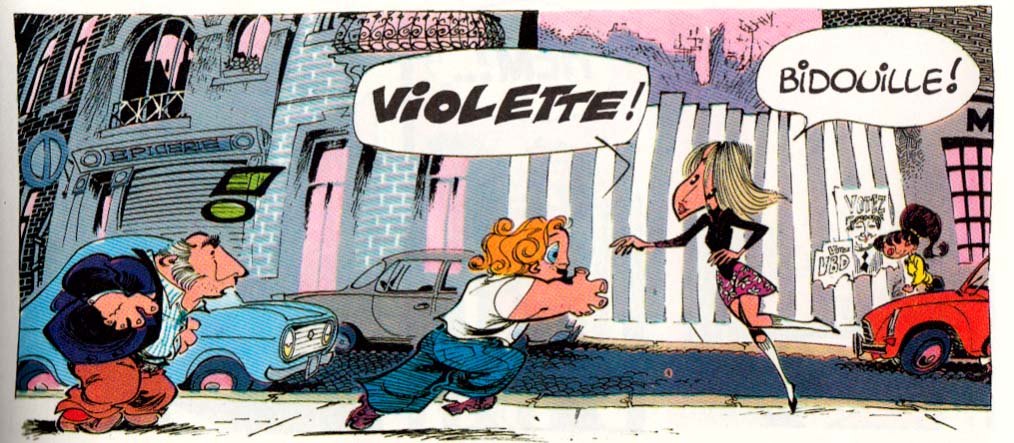  His style (or his graphisme, as the French would say) reminds me a little bit of Fred, the artist of Philemon, though they work in very different modes, of course.(1)
 His style (or his graphisme, as the French would say) reminds me a little bit of Fred, the artist of Philemon, though they work in very different modes, of course.(1)
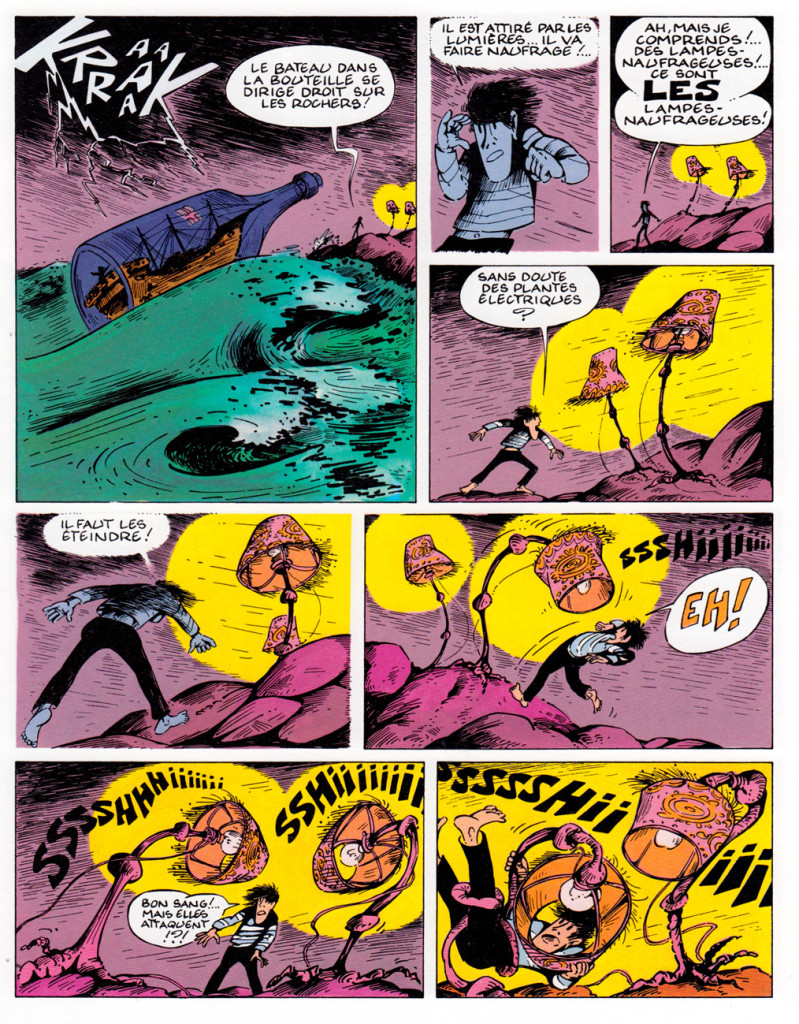
Hislaire especially excels at drawing the settings his characters inhabit and move through, using them to create mood, especially the cityscapes.
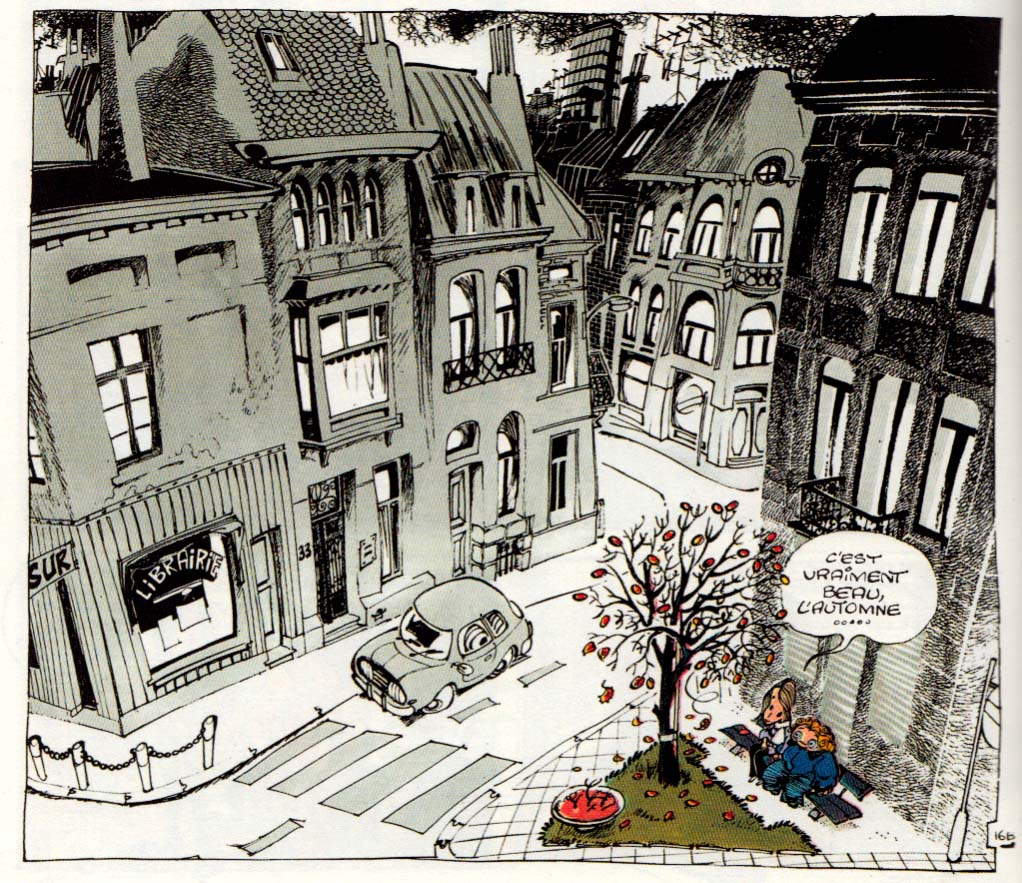 After Bidouille & Violette, Hislaire launched the series that really made him a bande dessinee star: Sambre, which ran in the new journal, Circus. Very very different from B&V, a more serious and adult romantic adventure, set against the French revolution of 1848, and drawn in a completely different, more “realistic” style. To punctuate this dramatic shift in style and tone, Hislaire even changed the spelling of his name to Yslaire. I haven’t read Sambre; I’d always lumped it in with what I consider a mediocre slate of historical comics in Circus, but, as with Bidouille & Violette, there’s something about the look of it that’s always intrigued me; I think I’ll give it a shot sometime soon.
After Bidouille & Violette, Hislaire launched the series that really made him a bande dessinee star: Sambre, which ran in the new journal, Circus. Very very different from B&V, a more serious and adult romantic adventure, set against the French revolution of 1848, and drawn in a completely different, more “realistic” style. To punctuate this dramatic shift in style and tone, Hislaire even changed the spelling of his name to Yslaire. I haven’t read Sambre; I’d always lumped it in with what I consider a mediocre slate of historical comics in Circus, but, as with Bidouille & Violette, there’s something about the look of it that’s always intrigued me; I think I’ll give it a shot sometime soon.
(1)NOTE: I should point out that two of Fred’s fantastic Philemon adventures were finally released in English this past year by Toon books – with no fanfare whatsoever. I haven’t seen the English versions, but these are really wonderful imaginative French classics, for all ages.
An update for my “recommended reading.” Â What I read and liked last month.
 Too many times people ask me, “what have you been reading lately?” and I don’t even remember. So here’s a way to keep track of/share at least some of what I’m into these days. I’m going to see if I can do it on a monthly basis, starting with
Too many times people ask me, “what have you been reading lately?” and I don’t even remember. So here’s a way to keep track of/share at least some of what I’m into these days. I’m going to see if I can do it on a monthly basis, starting with
OCTOBER 2014
Still working my way through the piles from SPX, MICE and Locust Moon Fest, among other reading sources. In fact a couple of these items  I’ve just caught up with after last year’s MICE!  Read more…
